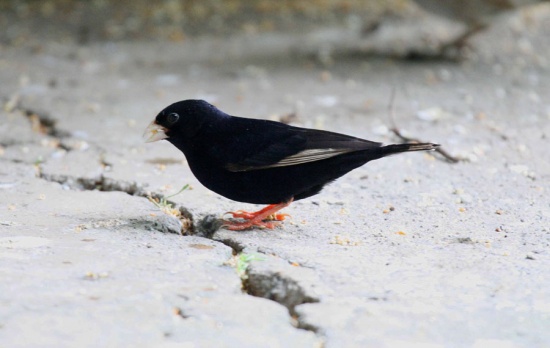- Vidua funerea
Also known as Variable Indigobird.
Identification
Length 11-12 cm, mass 15 g. Adult breeding male: Dull bluish or greenish black; Tail and flight feathers blackish brown. Eyes dark brown, bill white or pale pink, legs and feet orange-red. Adult non-breeding male and adult female: Head with bold buff and dark brown stripes and back buff, streaked black. Greyish white below, darker on breast and flanks.
Male gives harsh 'chichichichi' call; song incorporates both scratchy notes and trills and tinkling phrases from the song of the African Firefinch (host).
The southern race can be distiguished from other Indigobirds by the pale bill and orange-red legs and feet, but very similar too the Purple Indigobird north of the Limpopo; here best distiguished by call.
Distribution
Sub-Saharan Africa. Discontinuous; Malawi, much of Zambia, eastern Zimbabwe, parts of Mozambique, Swaziland, Lesotho and eastern South Africa. There are isolated populations in Tanzania, Kenya, Cameroon and Nigeria.
Taxonomy
Vidua funerea has two subspecies:
- V. f. funerea from eastern South Africa, Swaziland, Lesotho and Mozambique south of the Limpopo River; legs and feet orange-red in adult breeding male and pale purplish grey or pale orange in female; and
- V. f. nigerrima from eastern Zimbabwe northwards; slightly smaller than the nominate race; the legs and feet are pale purple in both sexes.
Habitat
Woodland, forest edges, grassy rank vegetation, cultivated lands and gardens.
Behaviour
Forages on bare and sparsely vegetated ground for small seeds. Takes termite aletes in flight. Males are conspicuous in breeding season when they call for long periods from a prominent perch. Females and nonbreeding males are inconspicuous, often feeding in mixed-species flocks.
Breeding: The Dusky Indigobird is a brood parasite, the host species being the African Firefinch.





